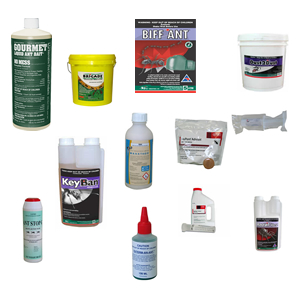
Control Tools
A wide range of products have been developed, and are still being developed, in the war against pest ants, although not all are effective in the control of Argentine ants. The field of ant control products is a dynamic one, with new insecticides and technologies being developed all the time. Many retail and commercial pest control products lay claim to their ability to kill ants, but may not have been independently assessed for their effectiveness against Argentine ants specifically, and not under New Zealand’s particular conditions.
The primary types of ant control products available are:
Baits
One of the major difficulties when it comes to baiting for Argentine ants is that their nests are not small, discrete and static units, but rather are just a part of a dynamic cooperative super-colony. Putting out a small amount of ant bait on your window sill because you have Argentine ants coming inside is like trying to control a forest fire with one bucket of water. Yes, you may temporarily put out some flames in one small patch of grass, but the fire rages on and will soon return to burn the grass.
Baiting operations to control Argentine ants will always be more effective when well-coordinated over as much of the infestation as possible. Individual Argentine ant nests will move or 'bud off' when something disturbs them, and it is commonly reported that nests will fracture when exposed to detectable but sublethal quantities of toxic bait, making it harder to control them.
Around the world, there seems to be two primary approaches to successful baiting for Argentine ants. The first, popular in the United States, is the use of very-low-toxicity carbohydrate baits delivered from relatively widely spaced bait stations. In this approach the Argentine ants continue to feed at bait stations for weeks and the toxin levels gradually increase and spread through the super-colony . The toxicity in the bait is so low that the colonies make no connection between the bait and increased mortality occurring so will continue to feed at the stations.
The second technique is to use more-toxic protein-based baits delivered at high densities across the infestation. In this approach the idea is that every sub-colony is within ready feeding range of the bait, and the toxin is very quickly dispersed throughout the super-colony. The use of protein in baits ensures it is delivered to the larvae and reproductives, and the whole nest is lethally affected in a matter of hours. In New Zealand, this is the commonly recommended approach, and has had excellent success using Xstinguish™ Argentine ant bait where it is possible to treat a significant proportion of the infestation.
A brief description of some of the baits that have been promoted for Argentine ant control in New Zealand is provided here:
Advion®Ant Bait Arenas
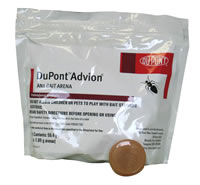
Active ingredient: 0.1% indoxacarb
The arenas were developed by DuPont™ as a ready-to-go bait station for the treatment of both ants and cockroaches. Each plastic arena contains 1.9 g of a protein-based bait. The bait is not as attractive to Argentine ants as other baits listed here, but they will forage on it at times and there is encouraging evidence for complete nest destruction when they do (indicating rapid sharing of the protein with queens and larvae). The arenas have a very long field life, with the main risk being premature consumption by non-target species, especially slugs and small snails. The arenas are currently available from a range of suppliers and can be purchased in bags of 30 stations.
Advion® Ant Gel

Active ingredient: 0.05% indoxacarb
This product is a carbohydrate-based gel sold in a 30-g syringe. Indoxacarb is a new-generation insecticide with a reduced risk to the environment because of its unique mode of action. The molecule requires exposure to enzymes in the insect’s digestive system to produce the real active. This means it is also quite slow acting, giving more time for the toxin to be circulated in the colony. Significant short-term reductions in Argentine ant foraging activity have been observed following the use of this product, but longer-term reductions in the populations from destruction of whole colonies has yet to be demonstrated here, and there is anecdotal evidence of ants ceasing to feed on the bait before that occurs. This bait has a long field life, and even when it does dry out, it can reabsorb water (from dew, sprinklers, or light rain) and become palatable again. The small package sizes, cost, and lack of evidence for colony destruction means we do not recommend this product for large-scale operations, but its reduced risk profile suggests it will be a useful product in some situations.
Ants In Ya Pants™
Active ingredient: 0.01% fipronil
This bait appears to be the same as the Xstinguish™ Argentine ant bait discussed below, but is specifically targeted to the householder and only available in the 100-g syringe units. It is marketed by Wet & Forget.
Exterm-an-Ant

Active ingredients: 80 g/L boric acid and 56 g/L sodium borate
Exterm-an-Ant is a liquid carbohydrate bait that is highly attractive to a variety of ants, including Argentine ants. Good results have been achieved with this bait on white-footed house ants (Technomyrmex jocosus), but the relatively high concentration of active in combination with a carbohydrate liquid may mean it is not so suitable for population-level control of Argentine ants. However, we are unaware of any formal trials using this bait in a large-scale attempt to control Argentine ants. Exterm-an-Ant is produced in New Zealand and available from a range of suppliers in 100-ml bottles.
Gourmet Liquid Ant Bait

Active ingredient: 1% disodium octaborate tetrahydrate
This liquid carbohydrate ant bait has not had much use against Argentine ants in New Zealand, but has been used overseas in association with AntPro bait stations to reduce populations of Argentine ants in orchards. The use of low toxicity bait in more widely spaced bait stations has not been properly explored in New Zealand, and may well have good application in residential areas where coordinated baiting is difficult to achieve and individual property owners need a more sustained treatment strategy to provide continued control. In New Zealand, Gourmet Liquid Ant Bait is available from Homesafe Products Direct in ready-to-use bait stations in 2- or 6-packs.
Xstinguish™ Argentine Ant Bait

Active ingredient: 0.01% fipronil
This product was specifically developed for the control of Argentine ants in New Zealand. It has been used extensively here and has a good record at significantly reducing populations in situations where a large proportion of a super-colony can be treated in a coordinated baiting campaign. Protein-based baits such as Xstinguish™ are a good way of targeting Argentine queens and larvae, as these are primarily fed protein and the toxin will get to them faster, whereas the workers themselves consume carbohydrates. The main drawback with this bait is its short field life, so timing of application to ensure a good uptake as quickly as possible is vital. It is available in 100-g syringes and 325-g caulking gun cartridges and is available from a range of pest control suppliers.
Residual surface sprays
A range of surface treatments are available for the control of invasive ants in New Zealand. These usually operate as a residual contact insecticide. Such products may be useful for both control and containment in some situations. Some are registered for indoor use, while others are for exterior use only, but the majority require application by approved handlers. Note that pesticides containing bifenthrin have been withdrawn from use in the European Union.
Arilon®
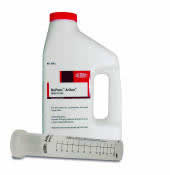
Active ingredient: 20% indoxacarb (as a water-dispersible granule)
Arilon® is a new-generation residual insecticide spray for use against ants, cockroaches and flies. It has an excellent safety profile and is registered for use on interior surfaces as well as outside. It has a non-repellent chemistry and is said to be suitable for a wide range of surfaces. It has not yet been properly assessed for efficacy against Argentine ants under New Zealand’s environmental conditions, but is potentially useful as an alternative for more-toxic surface treatments and especially for use indoors. It is only available to approved handlers.
Biff Ant

Active ingredient: 80 g/L bifenthrin
Biff Ant is a new spray-on surface treatment being developed by Key Industries specifically with the treatment of urban ant infestations in mind. Recent trial work has demonstrated the formulation retains excellent and prolonged activity on treated surfaces, including concrete, and has resistance to light–medium rainfall. It is also non-repellent to Argentine ants, even when recently applied, so has good potential for applications along roadside kerbing and paths as a containment tool as well as direct treatment around buildings, boundaries, and paved areas.
Keyban™

Active ingredient: 450 g/L chlorpyrifos
Keyban™ is a general-use insecticide spray that has been used against ants in some situations. It is an organophosphate insecticide, so should be used with particular caution. When first applied it acts as a fumigant as well as a contact insecticide. It is reportedly of low repellency to ants. This product is only available to approved handlers.
Maxxthor
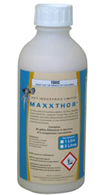
Active ingredient: 80 g/L bifenthrin
Maxxthor is a general-use residual insecticide spray that is registered for use both inside and outside. It has been used to treat both nests and surfaces where ants move across. It will be a safer option to use in some situations than organophosphate treatments. This product is only available to approved handlers.
Recruit™ 100 SC
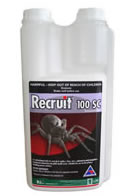
Active ingredient: 100 g/L bifenthrin
Recruit is a residual insecticide spray registered for use indoors, and is used to control spiders, ants, cockroaches, flies, and a variety of other insect pests in houses, shops, restaurants, and factories. It has NZFSA approval (Type B: fish, game, meat) and AsureQuality Category B approval for use in dairy factories. This product is only available to approved handlers.
Termidor ® 100 SC
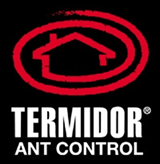
Active ingredient: 100 g/L fipronil
This product contains the same insecticide as found in the Xstinguish™ Argentine ant bait, but is in a suspension concentrate for application to exterior surfaces as a residual insecticide, or direct application onto nests. Termidor® is a non-repellent spay and should not be applied with sprayers previously used for other chemicals. The label data indicates residual activity persists for up to 3 months, and suggested application is once in spring when ant activity is increasing and a follow-up treatment applied in the summer, but no more than two applications per site per year. This is a controlled product and is only available to approved handlers.
Granular ground treatments
Granular treatments are designed to be sprinkled over earth, lawns, and gardens and have a residual-insecticide effect. These treatments could be very useful in situations where baiting is difficult or for mop-up operations where some remaining colonies are noticed after a wide-area baiting campaign, when it can be difficult to get ants back on the bait. They also have application as a barrier treatment around boundaries to help prevent unwanted reinvasion onto a treated property. Granular insecticides are also an excellent option for the treatment of potted plants where there is a risk of transporting ant propagules with the plant to new areas. Granules are generally activated by a light watering after dispersal. Note that pesticides containing bifenthrin have been withdrawn from use in the European Union.
Ant Stop G
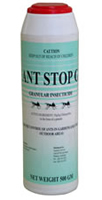
Active ingredient: 50 g/kg chlorpyrifos
Ant Stop G is a granular insecticide being promoted in New Zealand for the treatment of Argentine ants in particular. It has also been recommended for the treatment of potted plants and around rubbish tins to eliminate ant activity. Chlorpyrifos is an organophosphate and highly ecotoxic, so may be considered inappropriate for application in some areas.
Biforce Granular Insecticide
Active ingredient: 2 g/kg bifenthrin
Biforce ant sand is just one of several granular products that use bifenthrin (a synthetic pyrethroid) as the active ingredient. Bifenthrin is probably a safer option than organophosphate treatments in some situations. There is feedback from pest controllers that have achieved a good level of cost-effective control with the Biforce granules.
Brigade®
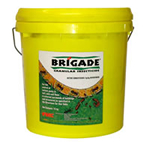
Active ingredient: 2 g/kg bifenthrin
Brigade® is another of the granular bifenthrin products that has been used on ants.
NO Ants Ant Sand
Active ingredient: 2 g/kg bifenthrin
Another insecticidal sand product containing bifenthrin. This one is marketed by Kiwicare under the NO product range and widely available in hardware stores.
NO Insects Lawngard Prills
Active ingredient: 50 g/kg diazinon
This granular product is for the control of a wide range of soil insects, including ants. It contains diazinon, an organophosphate insecticide than has been banned from non-agricultural uses in the USA, so should be used with caution. It is marketed by Kiwicare under the NO product range and widely available in hardware stores.
Space cavity treatments
Dust2Dust
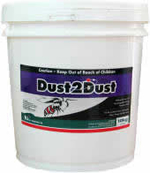
Active ingredient: 80 g/kg permethrin
Dust2Dust is used to treat difficult-to-access spaces, such as wall, ceiling and floor cavities. The dust is puffed into cracks or small holes with a bellows unit, and the microscopic particles are so light that they drift through the air to penetrate the entire cavity behind. This product is only available to approved handlers.
